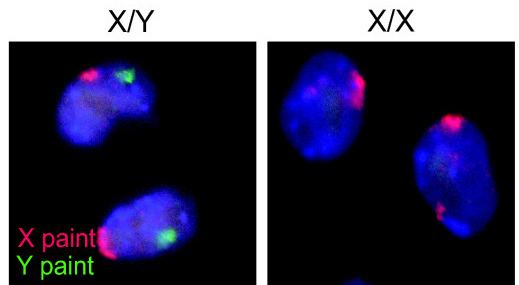Internal fertilization is the union of an egg cell with a sperm during sexual reproduction inside the body of a parent. For this to happen there needs to be a method for the male to introduce the sperm into the female's reproductive tract. In mammals, reptiles, some birds, some fish and certain other groups of animals, this is done by copulation, the penis or other intromittent organ being introduced into the vagina or cloaca. In most birds, the cloacal kiss is used, the two animals pressing their cloacas together while transferring sperm. Salamanders, spiders, some insects and some molluscs undertake internal fertilization by transferring a spermatophore, a bundle of sperm, from the male to the female. Following fertilization, the embryos are laid as eggs in oviparous organisms, or in viviparous organisms, continue to develop inside the reproductive tract of the mother to be born later as live young.
Fertilization which takes place inside the female body is called internal fertilization in animals is done through the following different ways:
Copulation, which involves the insertion of the penis or other intromittent organ into the vagina (in most mammals) or to the cloaca in monotremes, most reptiles, some birds, the amphibian tailed frog and some fish, the disappeared dinosaurs, as well as in other non-vertebrate animals.Cloacal kiss, which consists in that the two animals touch their cloacae together in order to transfer the sperm of the male to the female. It is used in most birds and in the tuatara, that don't have an intromittent organ.Via spermatophore, a sperm-containing cap placed by the male in the female's cloaca. Usually, the sperm is stored in spermathecae on the roof of the cloaca until it is needed at the time of oviposition. It is used by some salamander and newt species, by the arachnida, some insects and some mollusks.At some point, the growing egg or offspring must be expelled. There are several possible modes of reproduction. These are traditionally classified as follows:
Oviparity, as in most insects and reptiles, monotremes, dinosaurs and all birds lay eggs that continue to develop after being laid, and hatch later.Viviparity, as in almost all mammals (such as whales, kangaroos and humans) bear their young live. The developing young spend proportionately more time within the female's reproductive tract. The young are later released to survive on their own, with varying amounts of help from the parent (s) of the species.Ovoviviparity, as in the garter snake, most Vipers, and the Madagascar hissing cockroach, have eggs (with shells) that hatch as they are laid, making it resemble live birth.
